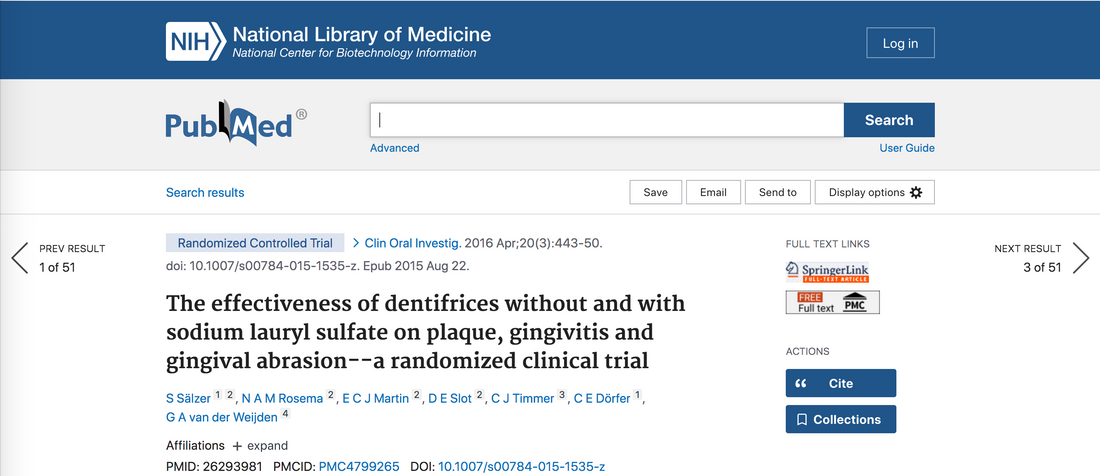The Effectiveness of Dentifrices Without and With Sodium Lauryl Sulfate on Plaque, Gingivitis, and Gingival Abrasion—A Randomized Clinical Trial
Published In: Clinical Oral Investigations
Publication Year: 2016
Study Design
This study was a randomized controlled double-blind clinical trial that compared the efficacy of a dentifrice without sodium lauryl sulfate (SLS) to a dentifrice with SLS in young adults.
Funding Sources
The study was funded by ACTA Dental Research BV with financial support from Sara Lee for the role of the Department of Periodontology of ACTA. One of the authors, Ms. Timmer, was a former employee of Sara Lee and currently works for Colgate-Palmolive.
PICO Framework - what was studied and how?
Population
-
Young adults aged 18–34 years.
-
Participants with moderate gingival inflammation (bleeding on probing at 40–70% of test sites).
Intervention
-
Dentifrice without SLS containing stearyl ethoxylate (30) EO and 1100 ppm sodium fluoride.
Comparison
-
Dentifrice with SLS containing 1.5% SLS, 1000 ppm sodium monofluorophosphate, and 450 ppm sodium fluoride.
Outcomes
-
Primary outcome: Bleeding on marginal probing (BOMP).
-
Secondary outcomes: Plaque scores, gingival abrasion scores, and participant satisfaction via visual analogue scale (VAS).
In Paragraph Form:
This randomized clinical trial investigated young adults aged 18–34 years with moderate gingival inflammation to compare the effects of a dentifrice without SLS versus a dentifrice containing SLS. The primary outcome was bleeding on marginal probing (BOMP), while secondary outcomes included plaque scores, gingival abrasion, and user satisfaction with the dentifrice's taste, freshness, and foaming effect.
Inclusion and Exclusion Criteria
Inclusion Criteria
-
Non-dental students from university colleges in and around Amsterdam.
-
Aged between 18 and 34 years.
-
Gingival bleeding of at least 40% at test sites.
-
Minimum of five evaluable teeth in each quadrant.
Exclusion Criteria
-
Less than 40% bleeding on probing.
-
Presence of dental caries.
-
Periodontal pockets >5 mm.
-
Orthodontic treatment.
-
Fewer than five evaluable teeth.
-
Extreme calculus or broken restorations.
-
Recent use of antibiotics.
Demographics and Study Design
-
Total Sample: 120 participants (58 in each group completed the trial).
-
Intervention Group (TD⊖SLS): 58 participants (50 females, 8 males).
-
Comparison Group (CD⊕SLS): 58 participants (41 females, 17 males).
-
Mean Age: Intervention group: 21.33 years (SD 2.53), Control group: 21.76 years (SD 3.59).
Participants were randomly assigned to either the test or control group and instructed to brush twice daily for 2 minutes using only the provided toothbrush and dentifrice for 8 weeks.
Primary Outcome Variables and Results
Bleeding on Marginal Probing (BOMP)
-
Baseline to 8-week reduction in BOMP was statistically significant within both groups (p < 0.001).
-
No statistically significant difference between the SLS and non-SLS groups at any time point (p > 0.05).
Plaque Scores
-
Both groups showed a significant reduction in plaque scores over 8 weeks (p < 0.001).
-
No statistically significant differences between the groups at any time point (p > 0.05).
Gingival Abrasion
-
No statistically significant differences in gingival abrasions between the two groups.
Visual Analogue Scale (VAS) Results
-
Participants preferred the taste, freshness, and foaming effect of the dentifrice with SLS (p < 0.001).
Simple Chart: Primary Outcome Variable Results
| Parameter | TD⊖SLS (Without SLS) | CD⊕SLS (With SLS) | p-value |
|---|---|---|---|
| BOMP at baseline | 0.80 ± 0.19 | 0.80 ± 0.19 | 0.923 |
| BOMP after 8 weeks | 0.60 ± 0.23 | 0.56 ± 0.24 | 0.375 |
| Plaque at baseline | 2.05 ± 0.47 | 1.99 ± 0.46 | 0.437 |
| Plaque after 8 weeks | 1.88 ± 0.36 | 1.82 ± 0.42 | 0.406 |
| Gingival abrasions | No significant difference between groups. |
Graph: Bleeding on Marginal Probing (BOMP) Reduction
Conclusions
The study concluded that:
-
A dentifrice without SLS was as effective as a regular SLS dentifrice in reducing gingival inflammation and plaque scores.
-
No significant difference was observed in gingival abrasions between the groups.
-
Participants preferred the taste, freshness, and foaming effect of the SLS-containing dentifrice.
-
For individuals prone to recurrent aphthous ulcers, SLS-free dentifrice may be a beneficial alternative.
Discussion: Strengths and Limitations
Strengths:
-
Double-blind design ensured objectivity.
-
Standardized conditions with identical toothbrushes and timed brushing.
-
Consideration of potential confounders such as interdental aids and other dental products.
Limitations:
-
Short duration of 8 weeks; longer-term effects remain unknown.
-
The study population consisted of young, healthy adults, limiting generalizability to older populations.
-
The subjective preference for SLS-containing dentifrice may influence compliance in real-world settings.
Citation
Sälzer S, Rosema NAM, Martin ECJ, et al. The effectiveness of dentifrices without and with sodium lauryl sulfate on plaque, gingivitis and gingival abrasion—a randomized clinical trial. Clin Oral Invest. 2016;20(3):443–450.


